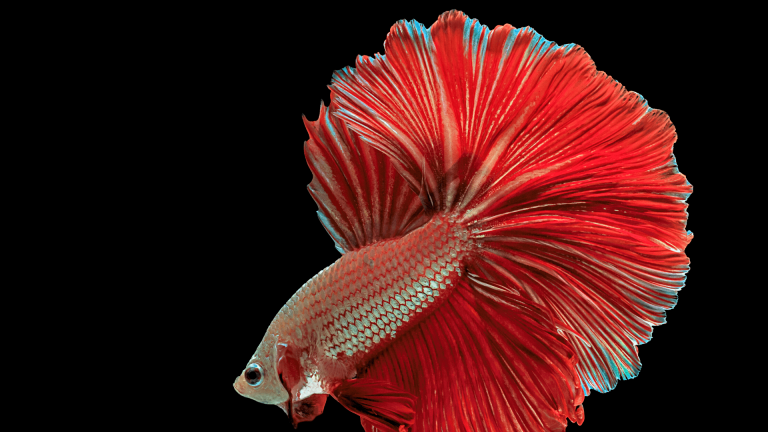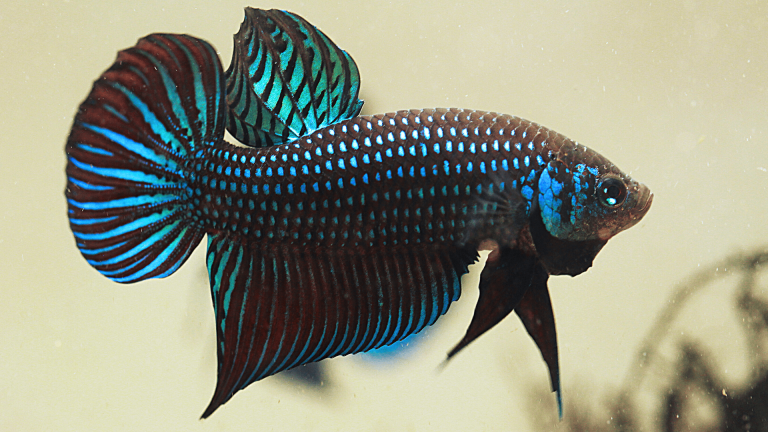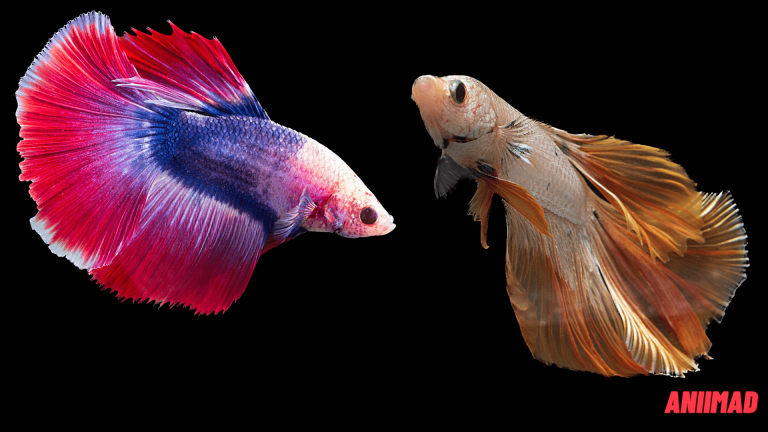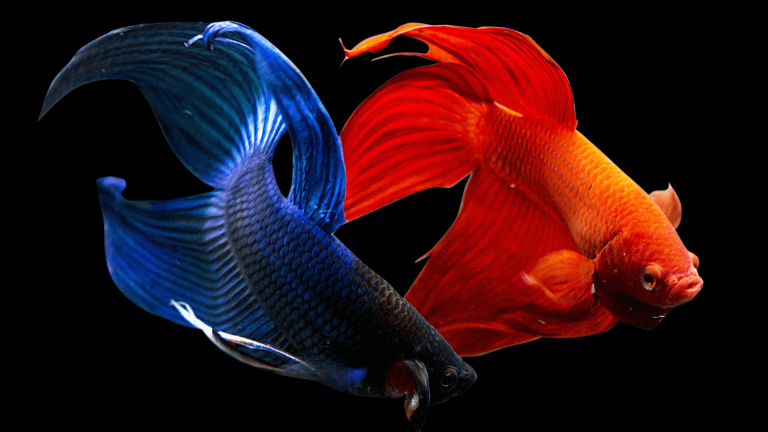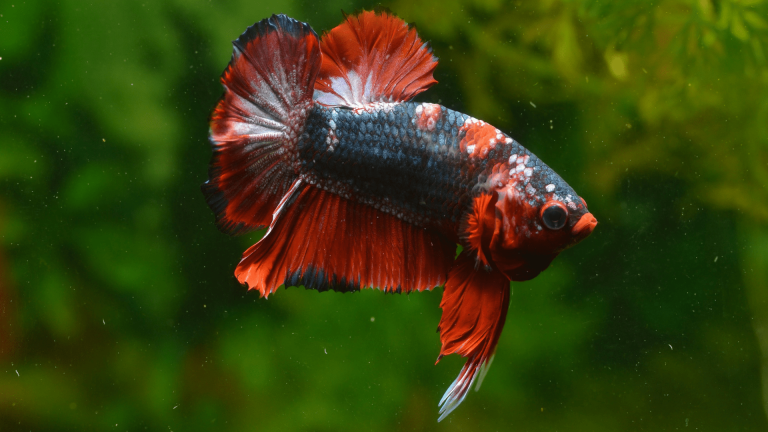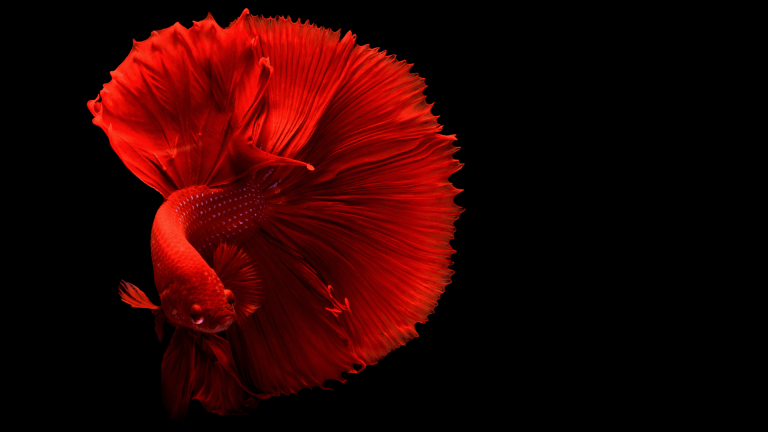Plakat Betta Fish: The Majestic Short-Finned Fighters of the Aquarium
With their vivid colors, flowing fins, and distinctive personalities, betta fish, sometimes known as Siamese fighting fish, have captured the attention of fans. Among these fish’s various traits and characteristics, one that often garners attention is the plakat trait. This article will explore what plakat is in betta fish and its significance in betta breeding and appreciation.
What is Plakat in Betta Fish?

Plakat, often abbreviated as PK, refers to a specific fin type found in betta fish. Unlike the long, flowing fins associated with traditional betta varieties, plakat bettas have short, neat fins that give them a more streamlined appearance. The word “plakat” is derived from the Thai language, meaning “short.” This trait naturally occurs in wild betta populations and has been selectively bred to create distinct plakat varieties.
What is the Difference Between a Plakat Betta Fish and a Betta?
The term “plakat” describes a specific type of betta fish. So, when we refer to a “plakat betta,” we are talking about a betta fish with the plakat trait. To clarify, let’s discuss the critical differences between plakat bettas and other types of bettas:
Fin Length
The most noticeable difference between plakat bettas and other bettas is the length of their fins. Plakat bettas have short fins than traditional bettas’ long, flowing fins. While different betta types may have elaborate and ornate fins, plakat bettas exhibit shorter, straight-edged fins and are less flashy.
Body Structure
Plakat bettas typically have a more robust and streamlined body structure. Their muscular and well-developed bodies allow them to be agile and swift swimmers. In contrast, other betta varieties may have more delicate or elongated body shapes.
Natural Instincts
Plakat bettas, due to their shorter fins and more muscular bodies, tend to exhibit more aggressive behavior than other bettas. It is because the plakat trait originates in the wild betta populations, where the fish evolved as fierce fighters. On the other hand, while all bettas have a natural inclination for territorial behavior, the extent of aggression can vary among different types.
Breeding Purposes
Plakat bettas often favor by betta breeders due to their unique traits. By selectively breeding plakat bettas, breeders can perpetuate and refine the plakat attribute, creating variations with different colors, patterns, and fin shapes. Other betta types are also bred for specific characteristics, such as long, flowing fins or vibrant colors, depending on the breeder’s preferences.
It’s important to note that “betta” is a broad classification encompassing various species and hybrid variations within the Betta genus. Plakat bettas are just one of the many types of bettas, each with distinct characteristics and traits. So, when discussing the difference between a plakat betta fish and a betta, comparing plakat bettas with other betta varieties is more accurate than referring to them as separate entities.
What is the Best Food for Plakat Betta Fish?

When feeding plakat bettas, providing them with a balanced and nutritious diet is essential. Betta fish are carnivorous, and their diet should primarily consist of high-quality protein-rich foods.
Here are Some of the Best Food Options for Plakat Betta Fish
Betta Pellets
High-quality betta pellets formulated explicitly for betta fish make an excellent staple food for plakat bettas. Look for shots that contain a good balance of protein, vitamins, and minerals. Ammunition should be small in size to accommodate the planet’s petite mouth.
Frozen or Live Foods
Plakat bettas benefit from occasional feedings of frozen or live foods. Options like bloodworms, brine shrimp, daphnia, and mosquito larvae are highly nutritious and mimic their natural diet. These foods provide variety and can help stimulate their hunting instincts. Ensure that live foods are from reputable sources to avoid introducing diseases into the aquarium.
Freeze-Dried Foods
Foods like bloodworms or brine shrimp can serve as occasional treats or supplemental feedings. These foods retain much of their nutritional value and are convenient to store. However, it’s essential to soak them briefly in tank water before feeding to prevent digestive issues, as they can expand in the fish’s stomach.
Vegetables and Supplements
While plakat bettas are primarily carnivorous, incorporating some vegetable matter into their diet can be beneficial. Blanch and finely chop peas, spinach, or lettuce can occasionally offer to provide fiber and aid digestion. Additionally, betta-specific supplements like betta-specific vitamins or specialized betta treats can use sparingly to supplement their diet.
Feeding Tips for Plakat Betta Fish
- Feed small portions: Plakat bettas have smaller mouths compared to other betta types, so ensure that the food is appropriately sized and easy for them to consume.
- Feed in moderation: Overfeeding can lead to health and water quality problems. Offer an amount of food to be consumed within a few minutes, adjusting as needed based on your betta’s appetite.
- Maintain a varied diet: Providing a diverse range of foods helps ensure your betta receives a well-rounded nutritional profile. Rotate between pellets, frozen/live foods, and occasional vegetable matter to keep their diet exciting and balanced.
- Regular feeding schedule: Establish a consistent feeding schedule, typically 1-2 small daily feedings, to maintain their health and avoid overfeeding.
Remember to observe your plakat betta’s behavior and adjust their diet accordingly. Every fish is unique, and factors such as age, activity level, and overall health can influence their dietary requirements.
What are the Features of Plakat Betta Fish?
Plakat bettas have several distinct features that set them apart from other betta varieties. Let’s explore some of the critical elements of plakat bettas:
Short Fins
The most prominent feature of plakat bettas is their short fins. Unlike the long, flowing fins seen in other betta types, plakat bettas have more temporary, straight-edged fins that appear less elaborate. Their caudal fins (tail fins) are typically rectangular or slightly rounded, giving them a more streamlined and agile look.
Robust Body Structure
Plakat bettas have a strong and muscular body structure. Their bodies are compact and streamlined, enabling them to be excellent swimmers. The firm body structure reflects their natural strength and agility.

Vibrant Colors
Plakat bettas are available in various vibrant colors and patterns. They can exhibit intense red, blue, yellow, black, and combinations of hues. Plakat bettas offer a stunning visual display from solid colors to marbling patterns.
Aggressive Appearance
Plakat bettas often appear more aggressive than other betta types due to their shorter fins and muscular body structure. This aggressive appearance is reminiscent of their wild ancestors, as plackets were initially breeding for their fighting abilities. It is important to note that while they may appear bold, each betta has its temperament, and not all plakat bettas are aggressive.
Diverse Fin Shapes
Although plakat bettas generally have short fins, there can be some variation in their fin shapes. While the caudal fin is typically straight-edged, some plakat bettas may have slightly rounded or slightly forked tails. The anal and dorsal fins of plakat bettas can also vary, ranging from short and neat to slightly elongated.
Hardy and Resilient
Plakat bettas are known for their hardiness and resilience. Their streamlined body structure and shorter fins make them less prone to fin damage or injury. They are generally considered easier to care for than other betta kinds and may adapt well to various water conditions.
High Stamina
Plakat bettas possess excellent stamina and endurance. Their shorter fins require less energy, allowing them to conserve their life for activities like swimming, exploring, and interacting with their environment.
Plakat bettas exhibit a unique combination of short fins, vibrant colors, robust body structure, and an aggressive appearance, making them a popular choice among betta enthusiasts and breeders. Their striking features and hardy nature contribute to their allure and make them a fascinating variety of betta fish to appreciate and care for.
Plakat Betta Fish Life Cycle

Like other betta fish, the life cycle of a plakat betta consists of several distinct stages. Let’s explore the typical life cycle of a plakat betta:
Egg Stage
The life cycle begins when a female betta lays eggs, usually attached to a nest constructed by the male betta. The eggs are translucent and spherical, and they typically hatch within 24 to 48 hours, depending on the water temperature.
Fry Stage
Once the eggs hatch, the baby bettas, known as fry, emerge. The fry is tiny and fragile at this stage, with underdeveloped fins. They primarily rely on their yolk sac for nourishment during the initial days. The male betta usually guards the fry and keeps them near the nest, ensuring their safety.
Free-Swimming Stage
As the fry grows, they enter the free-swimming stage, typically occurring within 5 to 7 days after hatching. At this point, the fry starts to swim actively and explore their surroundings. They begin to develop their fins, gaining more mobility and independence.
Juvenile Stage
As the plakat bettas grow, they enter adolescence. During this period, which lasts several weeks, the bettas experience significant growth in both body size and fin development. It is crucial to provide them with proper nutrition and a suitable environment to support their growth and development during this stage.
Sub-Adult Stage
Once the bettas have reached a specific size and their fins have fully developed, they enter the sub-adult stage. At this point, their colors become more vibrant and distinctive, showcasing the unique characteristics of the plakat variety. They continue to mature and prepare for adulthood.
Adult Stage
The adult stage marks the completion of the life cycle. Plakat bettas reach their full size and develop their mature colors and fin shapes. They are sexually mature and ready for breeding. The lifespan of a plakat betta can vary, but with proper care, they can live anywhere from 2 to 5 years on average.
It is important to note that these stages can vary in duration depending on water conditions, nutrition, and genetics. A suitable environment, appropriate diet, and regular care support healthy development and progression through each stage of the plakat betta’s life cycle.
Plakat Betta Fish Varieties

Plakat bettas come in various varieties, each displaying unique traits and characteristics. Here are some popular plakat betta fish varieties:
Solid Color Plakat
This variety features plakat bettas with solid, vibrant colors such as red, blue, yellow, black, or white. The fish’s entire body is a solid hue without any other patterns or markings.
Metallic Plakat
Metallic plakat bettas have a shiny, reflective appearance due to the presence of iridescent scales. Their scales reflect light, giving them a metallic sheen ranging from silver to gold, copper, or green.
Marble Plakat
Marble plakat bettas exhibit a marbled pattern on their bodies, consisting of a combination of two or more colors swirled together. The colors can be bold or subtle, creating a beautiful and unique mosaic-like pattern on the fish.
Butterfly Plakat
Butterfly plakat bettas have a distinct color pattern where the body is one color, and the edges of their fins are contrasting. It creates a striking “butterfly” effect, with fins resembling a butterfly’s wings.
Dragon Scale Plakat
Dragon scale plakat bettas possess a unique scale pattern characterized by thick, metallic scales with a “diamond” or “dragon scale” texture. These scales can be iridescent and come in a variety of colors.
Halfmoon Plakat
Halfmoon plakat bettas combine the plakat trait with the halfmoon trait, resulting in bettas with short fins that still have a wide spread when fully extended. When fully flared, these bettas have a semi-circular or “D”-shaped tail.
Crown Tail Plakat
Crown tail plakat bettas exhibit a modified plakat trait with fin rays extending beyond the fin membrane’s edges, resembling a crown. This variety showcases a unique and distinctive fin shape.
Giant Plakat
Giant plakat bettas, also known as “king plants,” is a larger variant of the plakat variety. They exhibit identical short fins and muscular body structures but reach significantly more extensively than standard plants.
These are just a few examples of the plakat betta fish varieties available. Betta enthusiasts and breeders continue to develop new and unique combinations, resulting in an ever-expanding range of plakat betta varieties with different colors, patterns, and fin shapes. The diversity within the plakat array offers a wide selection for fish keepers to appreciate and enjoy.
How to Care for Plakat Betta Fish
Caring for a plakat betta involves providing a suitable environment, a balanced diet, and proper maintenance. Here are some essential care guidelines for plakat bettas:

Tank Setup
- Tank Size: Provide a spacious tank of at least 5 gallons (19 liters) for a single plakat betta. A larger tank is always better as it allows more swimming space and ensures stable water conditions.
- Water Parameters: Keep the water’s pH between 6.5 and 7.5 and its temperature between 76 and 82 degrees Fahrenheit (24 and 28 degrees Celsius). Regulate the temperature with a trustworthy heater and thermometer, and periodically check the water’s purity using a test kit.
- Filtration: Install a gentle, adjustable filter to maintain water circulation and filtration. Bettas prefer calmer water, so adjust the filter flow if needed.
- Substrate and Décor: Use a soft substrate, such as sand or smooth gravel, to avoid damaging the betta’s delicate fins. Include live or silk plants, hiding spots like caves or driftwood, and smooth surfaces for the betta to rest on.
Feeding
- Provide a Balanced Diet: Feed your plakat betta a varied diet consisting of high-quality betta pellets as the staple food. Once or twice a week, add frozen or live meals like bloodworms, brine shrimp, or daphnia to their diet to help them get the vital elements they need.
- Portion Control: Feed your betta small portions twice daily, ensuring they consume the food within a few minutes. Overfeeding can lead to health and water quality problems, so avoid excessive feeding.
Water Quality and Maintenance
- Regular Water Changes: Perform frequent water changes of 25-50% weekly to maintain good water quality. Before adding it to the tank, a de-chlorinator filters chlorine and other dangerous chemicals from the tap water.
- Gravel Vacuuming: Use a gravel vacuum during water changes to remove accumulated debris and waste from the substrate.
- Monitor Ammonia, Nitrite, and Nitrate Levels: Regularly test the water parameters to ensure that ammonia and nitrite levels are at zero and are within acceptable ranges.
Behavioral and Environmental Enrichment
- Avoid Overcrowding: Plakat bettas are generally solitary fish and prefer their space. Do not house multiple bettas in the same tank unless for breeding purposes.
- Provide Hiding Places: Include plants, caves, or other hiding spots in the tank to create a sense of security for the betta.
- Gentle Lighting: Provide moderate lighting and ensure a day-night cycle, allowing the betta to have a regular sleep pattern.
- Stimulate Exercise: Regularly engage your betta in gentle exercise by providing objects like betta-safe toys, floating plants, or a mild water current.
Observe and Monitor
- Watch for Behavioral Changes: Keep an eye on your plakat betta’s behavior. Any sudden changes in appetite, lethargy, or abnormal swimming patterns could indicate a health issue.
- Regular Health Checks: Inspect your betta for signs of illness, such as fin rot, unusual spots, or bloating. Address any health concerns promptly.
Remember, each betta is unique, and individual care requirements may vary. By providing a well-maintained tank, a nutritious diet, and regular observation, you can ensure a healthy and happy life for your plakat betta.
Here are Some Frequently Asked Questions About Plakat Betta Fish
What is a plakat in betta fish?
Plakat refers to a specific fin type found in betta fish. Plakat bettas have short, neat fins that are straight-edged, in contrast to other betta varieties’ long, flowing fins.
Are plakat bettas different from other betta fish?
Plakat bettas are a type of betta fish. The term “plakat” describes the specific fin trait seen in these bettas. While plakat bettas have short fins, other betta types can have different fin shapes and lengths.
What are the advantages of keeping plakat bettas?
Plakat bettas have certain advantages:
- They are hardier and more resilient compared to long-finned bettas.
- Their short fins require less maintenance and are less prone to damage.
- Plakats exhibit strong swimming abilities and can be more active.
- Breeders find plakat bettas desirable for their breeding potential and the development of new color variations.
Are plakat bettas more aggressive than other betta types?
Plakat bettas can appear more aggressive due to their shorter fins and robust body structure. However, the aggression level varies between individuals; not all plakat bettas are inherently aggressive. Each fish has its temperament.
Can plakat bettas be kept with other fish?
Plakat bettas, like other bettas, are generally solitary fish and prefer to be kept alone. They can become aggressive towards other fish, especially those with long, flowing fins or bright colors. It’s best to house plakat bettas alone or in a well-planned community tank with compatible, non-aggressive tankmates.
Are plakat bettas suitable for beginners?
Plakat bettas can be a good choice for beginners due to their hardiness and ease of care. Their short fins are less prone to damage and generally more resilient to water parameter fluctuations than long-finned bettas. However, proper care, including maintaining suitable tank conditions and a balanced diet, is still essential for their well-being.
Can plakat bettas be bred?
Yes, plakat bettas can breed. The plakat trait is often selectively bred to develop new color variations and fin shapes. Breeding plakat bettas requires careful planning, suitable breeding conditions, and knowledge of the breeding process.
Do plakat bettas have shorter lifespans?
The lifespan of a plakat betta, like other bettas, can vary depending on factors such as genetics, care, and environmental conditions. With proper care, plakat bettas can live for about 2 to 5 years on average, similar to other betta varieties.
Conclusion
Plakat bettas are fascinating fish with their unique short fin trait. Their streamlined body structure, vibrant colors, and potential for varied patterns make them popular among betta enthusiasts and breeders. Plakat bettas offer several advantages, including their hardiness, ease of care, and breeding potential. Their shorter fins require less maintenance and are less prone to damage, making them suitable for beginner and experienced fish keepers.
While plakat betta fish can appear more aggressive due to their appearance, it’s important to remember that individual temperament can vary. Proper care, a suitable environment, and regular observation are crucial for ensuring the well-being of plakat bettas.
Whether you are captivated by their unique fin shape, interested in their breeding potential, or enjoy their vibrant colors, plakat bettas add a touch of beauty and excitement to any aquarium. Their presence can bring joy and satisfaction to fish enthusiasts, providing a rewarding experience for those who appreciate the diverse world of betta fish.

